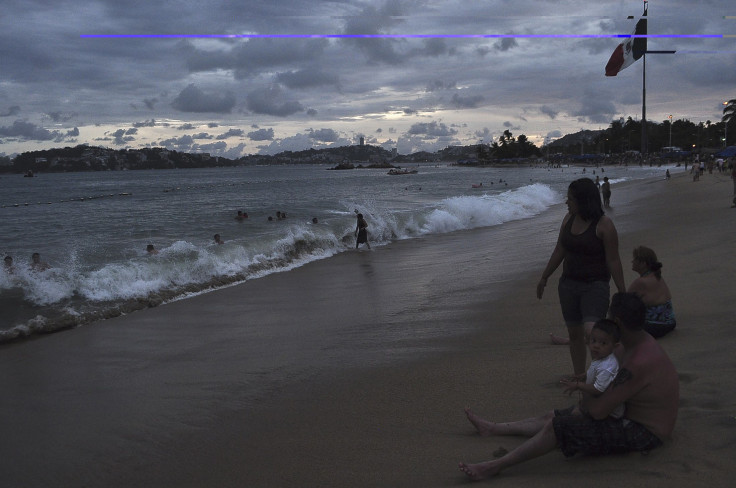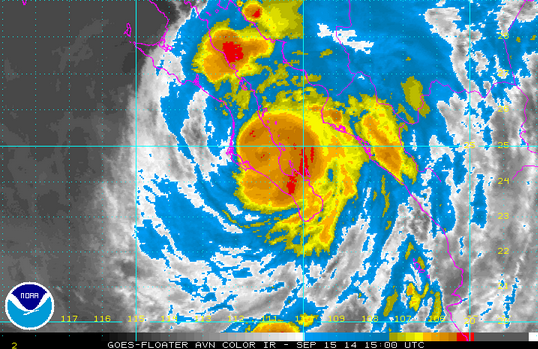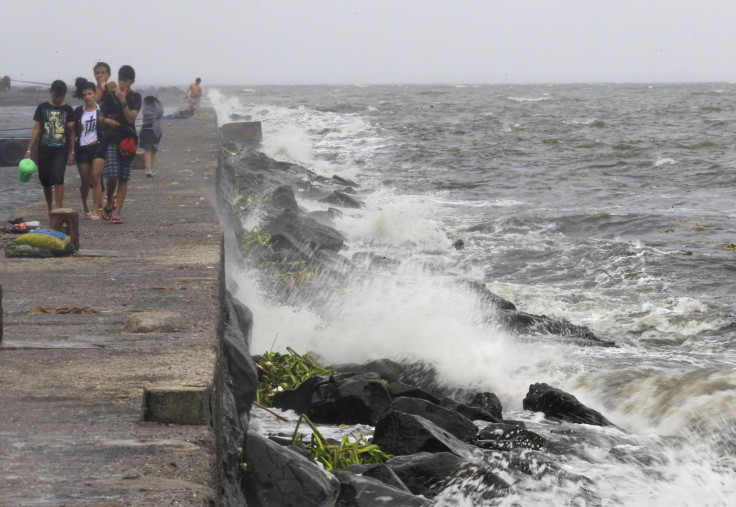Category 4 Hurricane Odile Expected To Make Pass At Baja Peninsula Within Hours

UPDATE 11:30 a.m., Sept. 15, EDT: The U.S. National Hurricane Center in Miami shows Hurricane Odile spiraling over the center of Baja Califonia Sur state, Mexico. Maximum sustained winds are near 100 mph (155 kmph), making it a Category 2 hurricane, down from Category 4 on Sunday morning. The storm battered Los Cabos, an economically important tourist resort zone at the tip of the peninsula.

Hotel shuttle van overturned. #odile #cabo pic.twitter.com/2m2wcA0piQ
— Sarah S. McKinney (@SSinArkansas) September 15, 2014Residents and tourists sent to shelters as Hurricane Odile makes landfall: http://t.co/t0czeS5Yk8
— World News Tonight (@WNTonight) September 15, 2014UPDATE 2 a.m., Sept. 15, EDT: Hurricane Odile has made landfall near Cabo San Lucas on the Baja California peninsula at about 9:45 p.m. PDT (12:45 a.m. EDT), according to reports. Odile, classified as a category-3 storm has a top wind speed of 25 mph, and the storm was moving north-northwest at 17 mph, according to Associated Press. Local authorities reportedly evacuated coastal areas and prepared shelters for up to 30,000 people in the region that is popular among vacationers.
UPDATE 8 p.m. EDT: Hurricane Odile neared the southern tip of the Baja California peninsula Sunday Evening, packing 125 mph winds and prompting hurricane hurricane watches and warnings over a wide area. At 5 p.m. PDT, the storm was 90 miles from the southern tip, moving north-northwest at 16 mph. Odile was expected to make landfall late Sunday or early Monday, then expected to start weakening, the National Hurricane Center in Miami reported.
UPDATE 3:30 p.m. EDT: Hurricane Odile was 290 miles west-northwest of Manzanillo, Mexico, and 185 miles south-southeast of the southern tip of Baja California, the National Hurricane Center said in its 11 a.m. PDT advisory. The storm was sporting sustained winds of 135 mph and moving northwest at 15 mph. Hurricane watches and warnings were en effect for most of the peninsula. Tropical storm warnings and watches also affected mainland Mexico.
Original post:
Hurricane Odile strengthened Sunday morning to a powerful Category 4 storm as it spiraled up Mexico’s West Coast. The U.S. National Hurricane Center in Miami indicated the eye of the hurricane may stay over the Pacific Ocean, but said much of the southern tip of the Baja California peninsula will feel the storm’s lash by Sunday night.
The storm’s maximum sustained winds measured 135 mph at around 5 a.m. PDT, when a hurricane warning was in effect for an area just north of Los Cabos, a popular and economically important tourist resort area known for its five-star luxury hotels and deep-sea fishing. The Saffir-Simpson Hurricane Scale defines Category 4 hurricanes as storms with maximum sustained winds of more than 131 mph. A storm hits the maximum Category 5 when sustained wind speeds break 155 mph.

Mexico’s national meteorological agency warned that the country’s states to the east and southeast of the peninsula would experience intense rainfall as the storm made its way up the western coast of Baja California Sur state.
In 1998, Hurricane Isis made a similar pass at the region as a Category 1 hurricane: It killed 14 people and destroyed hundreds of homes. Much weaker than Odile, the storm inflicted about $10 million in damages, mainly to the tourist infrastructure in Los Cabos. In 2002, Hurricane Kenna swung into the western coast of Mexico south of Baja as a Category 5 storm: It killed four, injured hundreds and destroyed thousands of homes. That storm inflicted $101 million in damages.
In the central Atlantic, Tropical Storm Edouard also gained strength Sunday morning. The storm is expected to reach hurricane strength Sunday, but it isn’t forecast to hit land. The storm’s center was situated about 950 miles east-northeast of the Leeward Islands and was headed northwest into open water.
#Hurricane Hunters prep to fly Hurricane Odile, a Cat 4, in the Pacific today. pic.twitter.com/VwtyowsV8j
— 403rd Wing (@403PA) September 14, 2014© Copyright IBTimes 2024. All rights reserved.






















